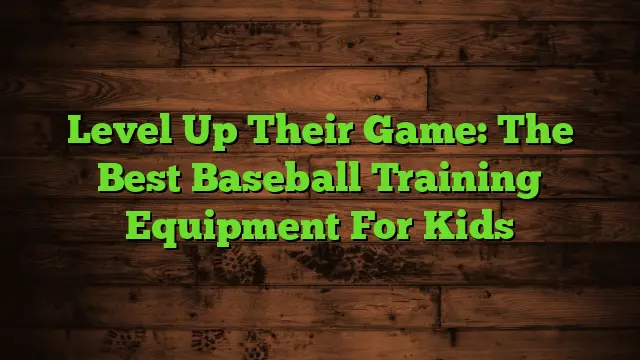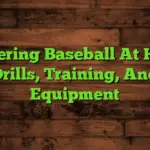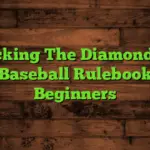Helping your child develop their baseball skills can be incredibly rewarding. This guide dives deep into the best baseball training equipment for kids, covering everything from fundamental tools to advanced training aids. We’ll explore the different types of equipment available, their benefits, how to choose the right ones for your child’s age and skill level, and how to incorporate them into an effective training regimen. By the end, you’ll be equipped to create a personalized training plan that helps your young athlete reach their full potential on the diamond.
Investing in quality baseball training equipment is crucial for a young player’s development. It provides a structured and focused approach to practice, enhancing skill acquisition, improving technique, and boosting confidence. This is far more effective than simply playing casual games. The
right equipment allows for targeted practice, correcting flaws early on, and building a strong foundation.
Types of Baseball Bats for Kids: From T-Ball to Youth League
Choosing the right bat is paramount. T-ball bats are typically lighter and shorter, prioritizing safety and ease of use. As players progress, they transition to larger, heavier bats that allow for increased power and distance. Consider factors like bat material (aluminum, composite, wood), weight, length, and the league’s regulations when making your selection.
Choosing the Right Bat Weight
A good rule of thumb is to select a bat that is roughly 2/3 of the child’s height in inches. However, always let the child test different weights to find what’s comfortable and allows for proper swing mechanics.
Gloves: Protecting Hands and Enhancing Control
A properly fitting glove is essential for comfortable catching and throwing. Youth gloves are designed with smaller hand openings and softer leather to accommodate younger players. Consider factors such as size, material (leather, synthetic), and webbing design. A well-broken-in glove will enhance grip and catching ability significantly.
Essential Protective Gear: Safety First
Safety should always be the top priority. This includes helmets, batting gloves, and protective cups. Helmets should be properly fitted and provide adequate protection. Batting gloves protect the hands during hitting, and a protective cup offers vital protection during gameplay.
Balls: From Soft Tosses to Hard-Hitting Practice
The type of ball used depends on the age and skill level of the player. Softballs are ideal for younger children starting out, while harder, regulation-sized baseballs are used as skills develop. Consider having a variety of balls on hand to cater to different training exercises.
Hitting Nets: Mastering the Swing in a Controlled Environment
Hitting nets offer a safe and convenient way to practice hitting. They are portable, allowing for practice anywhere, and help in improving batting technique without the need for a pitcher or a full field.
Pitching Machines: Automating Pitching Practice
Pitching machines provide consistent and repeatable pitches, allowing players to refine their batting technique without relying on a human pitcher. They are adjustable for speed and type of pitch, making them versatile training tools.
Base Running Equipment: Improving Speed and Agility
Agility cones, hurdles, and speed ladders can significantly improve base running speed, agility, and reaction time. These drills are vital for developing quick reflexes and efficient movement on the basepaths.
Fielding Equipment: Drills to Develop Defensive Skills
Ground balls, pop-up balls, and different fielding drills will improve fielding skills. Employing specialized tools like ground ball feeders or pop-up balls can help create consistent repetitions and develop muscle memory.
Strength and Conditioning Equipment: Building Strength and Endurance
Resistance bands, light weights, and bodyweight exercises can improve strength and endurance crucial for success in baseball. Incorporating such exercises into the training routine will help build the necessary physical attributes.
Baseball Training Aids: Focusing on Specific Skills
Numerous baseball training aids cater to specific skills like throwing accuracy, hitting power, and catching technique. These are commonly found in specialized sporting good stores, and online.
Choosing the Right Equipment Based on Age and Skill Level
Equipment choices should align with the child’s age and skill level. Younger players benefit from lighter, smaller equipment prioritizing safety and comfort, while older, more experienced players can benefit from more advanced, high-performance equipment.
Setting Up a Home Baseball Training Area
Creating a designated training area at home helps provide a consistent and dedicated space for practicing. A hitting net, pitching machine, and some agility equipment can transform a backyard or even a garage into a personal training facility.
Maintaining and Caring for Baseball Training Equipment
Proper maintenance prolongs the lifespan of baseball equipment. Gloves should be regularly oiled and conditioned, bats cleaned, and protective gear inspected for damage before each use. This prevents wear and ensures safety.
Budget-Friendly Options for Baseball Training Equipment
Investing in quality equipment doesn’t have to break the bank. Many affordable options provide excellent value and performance, offering a cost-effective way to upgrade the training experience. Consider used equipment or off-season sales.
Comparing Different Brands and Models of Baseball Equipment
Several reputable brands manufacture high-quality baseball equipment for kids. Researching and comparing different models based on factors like price, durability, performance, and features helps in making an informed decision.
The Importance of Proper Coaching and Guidance
Having a qualified coach or experienced mentor is instrumental in guiding the child’s development. They can provide proper instruction, correct flaws in technique, and create a personalized training plan. This is often overlooked but extremely vital for growth.
Frequently Asked Questions
What is the best age to start using baseball training equipment?
There’s no single answer; it depends on the child’s physical development and interest. Some begin with basic softballs and t-ball bats around age 4-5, gradually transitioning to more advanced equipment as they grow.
How much should I spend on baseball training equipment?
Budgets vary greatly. You can find affordable starter kits for under $100, but investing in higher-quality, longer-lasting equipment might cost several hundred dollars. Prioritize essential items (bat, glove, helmet) initially, then add others as needed.
What are the common mistakes parents make when buying baseball equipment?
Buying equipment that’s too big or too small is a common mistake. Always ensure a proper fit. Another is neglecting safety gear; prioritizing a helmet, batting gloves, and protective cups is non-negotiable.
How can I make baseball training fun for my child?
Incorporate games and drills into the training sessions. Make it interactive and engaging; focus on improvement and having fun rather than strict repetition. Reward effort and progress positively.
How often should my child practice using baseball training equipment?
Consistency is key. Aim for regular, shorter practice sessions (30-60 minutes) several times a week, rather than infrequent, long sessions. Avoid overtraining, allowing for rest and recovery.
Final Thoughts
Investing in the right baseball training equipment for kids can significantly improve their skills, enhance their enjoyment of the game, and boost their confidence. From choosing the right bat and glove to incorporating training aids and drills, the information outlined in this guide will help you create a personalized training plan that caters to your child’s specific needs and abilities. Remember that proper coaching and guidance remain crucial alongside quality equipment. By prioritizing safety, encouraging consistent practice, and fostering a positive learning environment, you’ll be empowering your young athlete to reach their full potential on the baseball field. So, get started, equip your young player for success, and watch their skills develop and flourish!





